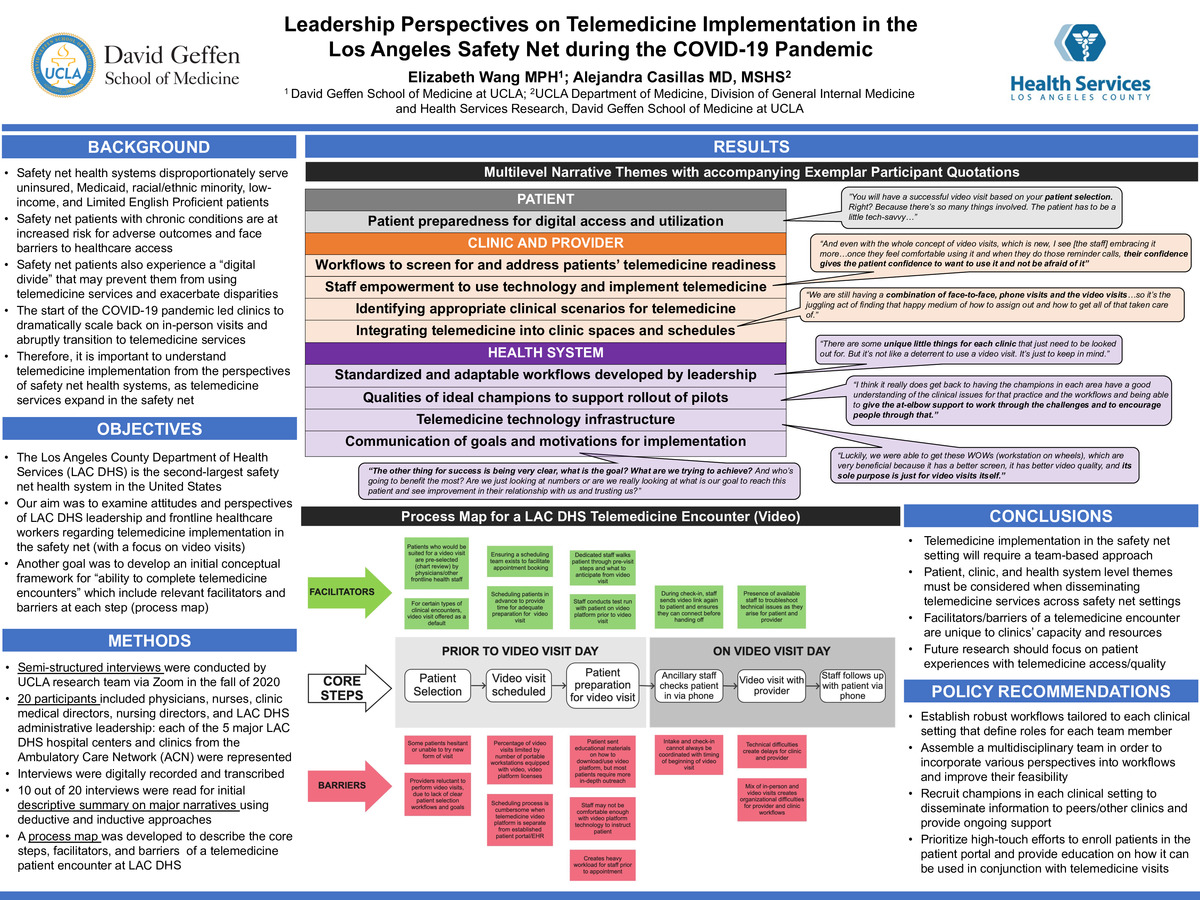-
Author
Elizabeth Wang -
PI
Alejandra Casillas MD, MSHS
-
Co-Author
Alejandra Casillas MD, MSHS
-
Title
Leadership Perspectives on Telemedicine Implementation in the Los Angeles Safety Net during the COVID-19 Pandemic
-
Program
STTP
-
Other Program (if not listed above)
-
Abstract
Background: The start of the COVID-19 pandemic led the Los Angeles County Department of Health Services (LAC DHS) safety net health system to dramatically scale back on in-person visits and abruptly transition to telemedicine services. LAC DHS, the second-largest safety net health system in the United States, disproportionately serves uninsured, Medicaid, racial/ethnic minority, low-income, and Limited English Proficient patients. In addition to barriers to healthcare access, safety net patients also experience a multilevel “digital divide” that may prevent them from taking advantage of telemedicine services, further exacerbating existing health disparities.
Objectives: (1) Examine attitudes and perspectives of LAC DHS leadership and frontline healthcare workers regarding telemedicine implementation in the safety net, with a focus on video visit. (2) Develop an initial conceptual framework for “ability to complete telemedicine encounters” which include relevant facilitators and barriers at each step of a patient encounter.
Methods: 20 semi-structured interviews were conducted via Zoom in the fall of 2020. Participants included physicians, nurses, clinic medical directors, nursing directors, and LAC DHS administrative leadership. Each of the 5 major LAC DHS hospital centers and clinics from the Ambulatory Care Network (ACN) were represented. Interviews were read for initial descriptive summary on major narratives using deductive and inductive approaches. A process map was developed to describe the core steps, facilitators, and barriers of a telemedicine patient encounter at LAC DHS.
Results: Narrative themes surrounding telemedicine implementation were identified at the patient, clinic/provider, health system levels with accompanying exemplar quotations. Themes included patient preparedness for digital access and utilization, staff empowerment to implement pilots, telemedicine technology infrastructure, and others. Core steps for a LAC DHS telemedicine patient encounter were described, as well as facilitators/barriers at each step.
Conclusions: Patient, clinic, and health system level themes discussed by LAC DHS leadership and frontline workers must be considered when disseminating telemedicine services across the safety net. In each clinic, unique facilitators/barriers will influence the process of a telemedicine patient encounter and can be addressed through robust workflows created by multidisciplinary teams. Moving forward, LAC DHS should prioritize high-touch efforts to enroll patients in tools such as the patient portal to increase equitable access to telemedicine services.
-
PDF
-
Zoom
https://uclahs.zoom.us/j/97496546839?pwd=Y3g2QUZzWDRadFI4WDh0ZUVoOVJGUT09

